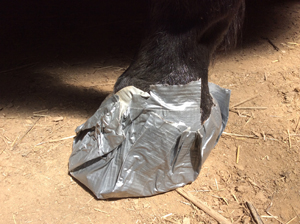duct tape boot Wilson

Photo Dr. Wendy Smith Wilson
As I turned the last pages of The Martian and set it on my hotel nightstand, I heard myself sigh. I was in a hotel and my luggage was lost. In the bathroom, I attacked the same dress I’d worn for the past 36 or so hours with the blow dryer because it had failed to drip dry overnight. It occurred to me that while the landscape of Mark Watney’s travails might be as far away as Mars, his attitude toward problem solving was pretty familiar.
Watney approaches his work just like large animal veterinarians do.
All debates about the state and cost of healthcare aside, in the developed world there is one consistency in human medicine: the equipment, aids, medicines, and instruments were all designed for the human patient.
In veterinary medicine, things are a little different.
If you treat only one or two species, you stand a chance of having the equipment or medication you need to cover most circumstances. After all, a horse is a horse, right? Well, unless the horse is a miniature horse. Or a draft horse somewhat larger than the average minivan. And a dog is a dog, but your average Malamute won’t fit into a standard pug mold.
When your job involves treating multiple species or taking your “hospital” on the road, the discrepancies involve more than just size, and so the need to create your own equipment becomes less a fluke and more an everyday occurrence.
I attended one of the best veterinary schools in the country (shameless shout-out to UC Davis), but there were still gaps in my education. I didn’t learn in school how to make a splint from a clothes hanger or what to do when a horse died in the stall at 2 a.m. or how to restrain a 500-pound pig with a bucket. I did, however, learn to make a mean duct tape patch.
Handing down the wisdom of duct tape to budding veterinarians was one of my favorite tasks as a practitioner.
Why duct tape? Well, when humans cut their foot, the instructions from the physician are pretty simple: stay off your foot, keep your bandage clean, don’t get it wet.
When a horse injures its foot, none of those instructions work. Trying to get a half-ton animal to use crutches is just silly. You wouldn’t want to eat off your horse’s living room floor, and even if you keep the stall scrupulously clean and dry I can pretty much guarantee that any horse worth its salt will find a way to stick the bandaged foot into some body of water.
This is where duct tape comes in. Overlapping strips (typically using the back of an unsuspecting veterinary student as a template) creates a nice water, dirt, and wear-resistant square that can be slapped onto the bottom of a bandage, giving several days before the bandage turns into an ankle bracelet.
One of my student ride-alongs was so excited about being permitted to bandage AND duct tape one of my patients that she went back and gushed to her small animal colleagues. Dog and cat veterinarians and staff can get a little uppity sometimes – after all, they have linoleum floors, shiny tables, and portable patients. So my student was teased about her “redneck” bandaging techniques.
I’ve seldom been more proud of a protégé than when she told me her retort. “Hey! REAL vets use duct tape!”
Truth be told, I doubt there is a single veterinarian of any flavor with more than a few years of experience who hasn’t learned the art of medical equipment improvisation. I’ve seen E-collars (the dreaded cone of shame) made for birds and small kittens out of X-ray film and cloth tape; splints made of Popsicle sticks or toothbrushes and a little cotton; a salmon net used as a feral cat trap. I’ve made (or had technicians help me make) X-ray grids (to mark the exact location of a lesion) with surgical steel wire and cloth tape, splints out of wire, cotton, and tape, boots out of old IV fluid bags, and a pig restraint/anesthesia mask out of a bucket and an old pair of jeans.
Now that you know the link between the dress, book, and tape, you may wonder why you should care.
Here is my answer:
In veterinary medicine there is science and there is art. Science tells us how our patients’ bodies work and often what to do when they don’t. Art helps us figure out ways to make the science practical. Just as each artist has a signature brush stroke or color palette, different veterinarians have likely worked out different “improvs” over the years. I like duct tape. Another practitioner may prefer a patch of inner tube. We’re both right. And we're both artists in our own right.
1 Comment
Vince Curto
July 25, 2016